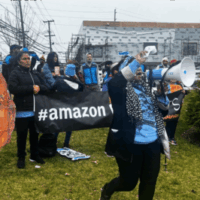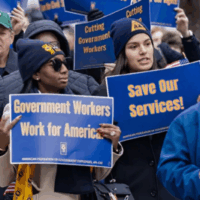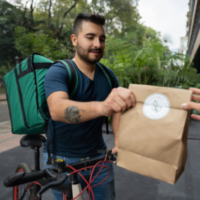As we come into the sixth month of social distancing and a myriad of overlapping, co-constitutive crises, it’s both easy and difficult to forget how radically unequal the crises have been.[1] The ease in forgetting is a strategic component of the inequality itself: the inability to pay appropriate attention to the unfathomable loss we are moving through defines the limits of what we feel is politically or socially possible. But uprisings remind us. Uprisings give those of us who lost track the space to pay attention again.
It’s unacknowledged: as of late August, over 200,000 people have died in the US from the pandemic. The US averages 1,100 deaths a day. There is radical inequality in our mass death. Deaths among Latinx, Asian Americans, Indigenous people, and Black people have increased at rates several times over the death rate among white people. People incarcerated in federal and state prisons are 550% more likely to contract COVID-19 and 300% more likely to die from it than someone outside (local jails were not included in this study). Daily, workers categorized as “essential” are forced to risk their lives to maintain an income. Their work – maintaining basic life-services that keep everyone alive – is particularly stark when it caters to those who are privileged enough to socially quarantine.[2] This sheer destruction of human life is coupled with a deadly and racialized narrative on the origins and outcomes of the pandemic.[3] Now, as ever, radical inequalities are made to appear ordinary.
Our country’s radical inequalities have long operated this way: inequality is, on the one hand, the policy choice of material deprivation for some and material plenty for others, and, on the other, the implicit story institutions tell about why that deprivation is not only necessary, but also deserved. Racialized and gendered inequality have defined both workplaces and social insurance programs in this country from the very beginning.[4] Racism and sexism govern whether you begin with the 1935 Social Security Act (creating an unemployment insurance program which excluded industries where Black workers, and in particular Black women, predominated) or you begin further back with the legislated concept of whiteness as both legal protection from enslavement and as legal access to waged labor (to say nothing of property ownership, suffrage, and the jury). To pretend otherwise is ahistorical and out of touch with racism – the ordinary, institutionalized ways, as abolitionist Ruth Wilson Gilmore writes, the state sanctions or produces “group-differentiated vulnerability to premature death.”
In our current context of unequal mass death, it’s a plain fact that’s often obscured: whether and how an individual accesses the workplace, its generated income, and social insurance programs determines that person’s basic access to health, safety, and the stability to plan for their future.[5] Whether you are an employee, self-employed, an employer, or an investor, you derive income from a workplace. How (and whether) individuals access workplaces and/or social insurance is a question of which inequalities are seen and which are made ordinary. Blaming individuals for fundamentally social, institutional problems — such as the country’s refusal to engage a public health infrastructure in a global pandemic — is the narrative attack strategy that makes radical inequality ordinary. In a pandemic, it promotes mass death. It’s also the same narrative strategy long at work in the carceral legal system.
As abolitionists and activists have taught us, like the pandemic, the US carceral legal system[6] is an engine of radical inequality, albeit a more longstanding one. At every level of the US carceral system (policing, arrest, jail, bail setting, trial, plea coercion, sentencing, prison, probation, parole, and ongoing punishment of having a record) radical race and class inequality persist, as well as an invisibilized increase of the care burden disproportionately placed on women of color. Stemming in part from decades of US deindustrialization as workers movements demanded occupational integration and higher pay, Black women are now increasingly both disproportionately employed in the unsafe, unhealthy, undesirable, and poorly-paid jobs that prisons and jails create, as well as are disproportionately put in the position of supporting loved ones incarcerated by that same system.[7]
And here too, administering radical racial and class inequalities is not the only thing the carceral legal system does. It also messages the justice of inequality: the carceral legal system makes its own inequalities ordinary and easy for many to forget. It broadcasts its own stories about what individuals do to deserve social punishment. Its foundational race, gender, and class inequalities are obscured by a bombastic, belligerent, and moralizing “War on Drugs,” “War on Crime,” or “War on Gangs.” The purpose of mobilizing war is to promote making peace with otherwise intolerable outcomes. War overshadows the daily racialized criminalization of addiction and trauma, the militarization of police, the economic transition from industrial-factory towns to “prison towns,” and even cultural representations idolizing prosecutors and police. It makes ordinary brutal forms of radical inequality couched in the language (and the public-private funding machinations) of war.[8] Mobilizing war obscures how angry we may be – and how legitimate that anger may be – in the face of centuries of unacknowledged racial violence and class warfare.
At various points in the legal system where physical liberty is made possible (bail, sentencing, probation revocation, or parole), the carceral legal system demands remorse, a final act of prostration, as though the process were not already a ceremony of protracted resource extraction, racial and class humiliation for all parties, job loss, eviction, fines and fees. Ultimately, as abolitionists have long brought to the forefront, the carceral legal system makes the false equivalence that safety from harm is a sprawling system of militarized police, jails, prisons, and surveillance. Any challenge to abolish, dismantle, or defund that system is equated to apocalyptical mass violence from outsiders, deflecting from its own violence and harm.[9]
Social movements and uprisings interrupt the story institutions tell to make radical inequalities ordinary. Uprisings remind us that the scale of both US mass death in the face of this pandemic and the carceral system are exceptional and are political choices. We’ll remember that hidden beneath every bail hearing, deportation hearing, beneath every CARES Act application that determines which-sort-of-person doing what-kind-of-work is included — is ultimately a political question of belonging.
This question of belonging has long driven NELP’s prioritization of excluded workers and unrecognized forms of work. In our new resource, we address frequently asked questions for navigating the economic crisis with an arrest and/or conviction record, with a focus on accessing unemployment insurance programs in the CARES Act. You can access the growing body of FAQ’s here. We began this process with our partners’ questions and intend to expand this document as additional questions arise (and as federal recovery programs change). Please contact us for any additional information or questions you would like to see addressed.
Endnotes
[1] The stock market has just closed out its best August in 36 years. Just a week earlier, the Federal Reserve Bank reported that the wealthiest 10% own 87% of all stocks in the US, an increase from 79% in 1990. In early March, before cities like New York quarantined, the Federal Reserve Bank injected 1.5 trillion dollars into the stock market, and later, several more trillions in loans whose terms favored large corporations.
[2] Women represent the majority of “essential workers” while Black women and Latinx women in particular are hit hardest by joblessness. Given the terms of both unemployment insurance and Pandemic Unemployment Assistance, those in the formal and informal economies are forced to choose between safety and a reliable source of income. For more information, please see NELP’s FAQs on access to recovery benefit programs..
[3] The white nationalist narrative about racial backwardness and cultural deficiency binds together a fantasy about white superiority abroad and at home: moralizing disgust against purported Chinese dietary habits (exhibited at Chinese farmers’ markets) as existentially responsible for disease and the obsession over purported Black dietary habits as responsible for Black COVID-19 death.
[4] As forms of group-differentiated inequality, racism and sexism describe both the policy choice of deprivation and the story institutions tell to justify the choice.
[5] Health, safety, and the stability to plan for one’s future are the building blocks of individual liberty, not, incidentally, the unregulated ability to juice every ounce of profitability out of someone else’s labor.
[6] The carceral legal system is generally called the “criminal justice system” just as the deportation legal system is generally called the “immigration legal system,” both obscuring their actual and normalized outcomes.
[7] The numbers describing the fundamental racism of the carceral legal system are by now familiar to advocates: who is stopped, who is arrested, whose arrests result in death, the cost of bail, the severity of sentencing, whose probation is revoked, who is successful in obtaining release at a parole hearing, or how the death penalty is pursued, is best understood through a lens of race and class inequality. And as those who follow Ban the Box and Fair Chance Licensing campaigns know, people are fighting back against the records system that puts up work barriers once someone is formally done with the carceral legal system and increases unemployment, lost earnings, and economic reliance on loved ones. See excellent collections of additional studies here and here.
[8] These wars enable the carceral legal system’s most recent economic, technological, and cultural expansions. This includes the above-mentioned “War on Drugs,” “War on Crime,” “War on Gangs,” as well as the carceral legal system’s involvement in the “War on the Border,” “War on Terror.” In recovery, it includes the transnational language of “refugees” tagged to Black New Orleanians as fundamental outsiders following Hurricane Katrina.
[9] That, incidentally, is the defensive, dodging rhetoric of intimate partner violence




